CU-5 Normal form of a cubic equation
General form of a cubic equation
A cubic equation in barycentric coordinates can be expressed in general form as:
c1 x3 + c2 y3 + c3 z3 + c4 x2 y + c5 x2 z + c6 x y2 + c7 y2 z + c8 x z2 + c9 y z2 + c0 x y z = 0
where the coordinates refer to a reference triangle ABC with vertices (1 : 0 : 0), (0 : 1 : 0) and (0 : 0 : 1).
Simplification of the cubic equation
The following simplification of a cubic equation is based on the theory of Hesse’s Form and was further developed in a discussion within the QPG Group in 2024/2025 (see [66]), where Bernard Keizer was the initiator and driving force behind the problem, contributing the majority of input.
When a reference triangle is chosen, the corresponding reference points play a pivotal role. Each target point is defined by coordinates relative to these reference points. To express the same target point in relation to a second reference triangle, a point reference transformation is required. This transformation pTf can be formulated as follows.
Let target point X(x,y,z) be identified with respect to a reference triangle with vertices (1 : 0 : 0), (0 : 1 : 0) and (0 : 0 : 1). Let triangle P1(p1x : p1y : p1z), P2(p2x : p2y : p2z), P3(p3x : p3y : p3z) be the second reference triangle. Then the new coordinates of X with respect to triangle P1P2P3 will be defined by:
pTf (P1, P2, P3, X) =
(Det[(X, P2, P3)] (p1x+p1y+p1z),
Det[(P1, X, P3)] (p2x+p2y+p2z),
Det[(P1, P2, X)] (p2x+p2y+p2z)),
where Det is the determinant of the 3×3-matrix formed by the 3 sets of point coordinates indicated.
The point reference transformation applied for all points (x,y,z) on CU from reference triangle (1 : 0 : 0), (0 : 1 : 0) and (0 : 0 : 1) to reference triangle P1,P2,P3 will use pTf-1 for alle points on CU.
Let H1H2H3 be the real flex triangle H1H2H3 of the reference cubic. This is the triangle bounded by the 3 real flexlines, each passing through one of the 3 real flexpoints.
First normal form of a cubic equation
When the reference triangle is changed to this flex triangle, the equation of the cubic simplifies to a form, here called the first normal form:
- b1 x3 + b2 y3 + b3 z3 + b0 x y z = 0.
In order to connect to later developments the first normal form is rearranged to:
- a13 x3 + a23 y3 + a33 z3 + k a1 a2 a3 x y z = 0
So when we work with the real flex triangle H1H2H3 as reference triangle then there are coefficients (a1, a2, a3, k) such that:
- CU = a13 x3 + a23 y3 + a33 z3 + k a1 a2 a3 x y z = 0
Second normal form of a cubic equation
Another transformation can be applied mapping (a1 x) x, (a2 y) y, (a3 z) z, resulting in the second normal form:
- x3 + y3 + z3 + k x y z = 0
This form is known as Hesse’s Form.
Thus, after performing two transformations, the equation of a cubic in its general form is transformed (projectively equivalent) into Hesse’s form.
For a proof of the existence of a projectively equivalent mapping from any smooth cubic in general form to Hesse’s form see [75], page 4 and [76], page 2.
Flexpoints, Flexlines and Harmonic Polars in first normal form
After the projective transformation next coordinates/equations follow from consequent calculations.
The 9 flexpoints are
- F1 = (0, -a3, a2) real point
- F2 = (-a3, 0, a1) real point
- F3 = (-a2, a1, 0) real point
- F4 = (0, -i2 a3, a2) imaginary point
- F5 = (0, -i1 a3, a2) imaginary point
- F6 = (-i2 a3, 0, a1) imaginary point
- F7 = (-i1 a3, 0, a1) imaginary point
- F8 = (-i2 a2, a1, 0) imaginary point
- F9 = (-i1 a2, a1, 0) imaginary point
where i1 and i2 are the primitive cube roots of unity: i1 = (-1)2/3 and i2 = -(-1)1/3. See Note-1.
The coordinates of all flexpoints show that they all lie on one of the sidelines of the reference triangle.
The 12 Flexlines are:
- L123 = (a1, a2, a3) real Flexline F1F2F3: a1 x + a2 y + a3 z = 0
- L145 = (1, 0, 0) real Flexline F1F4F5: x = 0
- L267 = (0, 1, 0) real Flexline F2F6F8: y = 0
- L389 = (0, 0, 1) real Flexline F3F7F9: z = 0
- L179 = (i2 a1, a2, a3) imaginary Flexline F1F7F9
- L168 = (i1 a1, a2, a3) imaginary Flexline F1F6F8
- L258 = (a1, i2 a2, a3) imaginary Flexline F2F5F8
- L249 = (a1, i1 a2, a3) imaginary Flexline F2F4F9
- L346 = (a1, a2, i2 a3) imaginary Flexline F3F4F6
- L357 = (a1, a2, i1 a3) imaginary Flexline F3F5F7
- L478 = (a1, i1 a2, i1 a3) imaginary Flexline F4F7F8
- L569 = (a1, i2 a2, i2 a3) imaginary Flexline F5F6F9
where i1 and i2 are the primitive cube roots of unity: i1 = (-1)2/3 and i2 = -(-1)1/3. See Note-1.
Note that after the projective transformation indeed the triangle bounded by L145, L267, L389 is the new reference triangle with sidelines (1,0,0), (0,1,0), (0,0,1), and consequently with vertices H1(1,0,0), H2(0,1,0), H3(0,0,1) of the new reference triangle.
The 9 Harmonic Polars are:
- L1 = (0, a2, -a3) real line
- L2 = (a1, 0, -a3) real line
- L3 = (a1, -a2, 0) real line
- L4 = (0, a2, -i2 a3) imaginary line
- L5 = (0, a2, -i1 a3) imaginary line
- L6 = (a1, 0, -i2 a3) imaginary line
- L7 = (a1, 0, -i1 a3) imaginary line
- L8 = (a1, -i2 a2, 0) imaginary line
- L9 = (a1, -i1 a2, 0) imaginary line
where i1 and i2 are the primitive cube roots of unity: i1 = (-1)2/3 and i2 = -(-1)1/3. See Note-1.
Harmonic Polar-Crosspoint P0
The 3 real Harmonic Polars are concurrent in P0 (1/a1, 1/a2, 1/a3).
P0 is the trilinear pole wrt the reference triangle H1H2H3. of the real Flexline F1F2F3: L123.
Conversely L123 is the trilinear polar of P0 wrt the reference triangle H1H2H3.
The Hessian of CU
We know:
CU = a13 x3 + a23 y3 + a33 z3 + k a1 a2 a3 x y z = 0
After calculation the Hessian HE of CU appears as:
HE = a13 x3 + a23 y3 + a33 z3 + k’ a1 a2 a3 x y z = 0
where k’ = -(108 + k3) / 3
The Syzygetic Pencil
All Cubics passing through the 9 Flexpoints of CU are called cubics of the Syzygetic Pencil.
CU and its Hessian mutually intersect in the 9 Flexpoints of CU. Therefore they are called members of the Syzygetic Pencil.
The 3 sidelines of the real flex triangle H1H2H3 (being the 3 real flexlines resp. through F1, F2, F3) form together also a degenerate cubic, which will be called here RF. On these 3 lines all 9 Flexpoints occur. So it is also a member of the Syzygetic Pencil.
Since it is a pencil every Cubic in it can be described as t CU1 + (1-t) CU2, where CU1 and CU2 are also members of the pencil.
We now ask the question of finding a cubic FE as linear combination of CU and HE such that RF is its hessian.
Specifically we need to find CUx = Hessian of t CU + (1-t) HE.
It appears that there are 9 values of t that provide a solution.
However, upon substituting these values of t, it turns out that there are only 2 distinct solutions.
- FE = a13 x3 + a23 y3 + a33 z3
and
- RF = a1 a2 a3 x y z.
FE is the main part and will be called here the Core Curve, RF is the degenerate part and will be called here the Residual Curve.
RF is actual the degenerate cubic consisting of the three sidelines (x=0, y=0, z=0) of the reference triangle, which are the three real Flexlines, which indeed contain the 9 Flexpoints.
Moreover FE and RF are derived from the pencil t CU + (1-t) HE and therefore both pass through the 9 Flexpoints and consequently are members of the Syzygetic Pencil.
It also appears that FE and RF share the same Hessian, namely RF.
Hessians and PreHessians
Since a Hessian is also a cubic, it is also possible to calculate the Hessian of the Hessian, and further downwards.
Moreover it is possible, knowing some cubic CU, to find out for which upper cubic CU is the Hessian. There are 3 of these cubics called the PreHessians pHE1, pHE2, pHE3.
So per definition the Hessian of all three cubics pHE1, pHE2, pHE3 will be CU.
So “upwards” there are 3 PreHessians of a cubic and “downwards” there is 1 Hessian per cubic.

CU-3Cu1 CU-HE-pHE1-pHE2-pHE3 picture-03.fig
From the equations of t1, t2, t3 it follows that there will be three real preHessians when k <= -3. When k > -3, there will be one real preHessian and two imaginary preHessians.
Examples
The 3 PreHessians of FE are also of the form FE + k.RF. Its Hessian is RF.
The 3 PreHessians of RF are RF itself and FE (counting twice). Its Hessian is again RF.

CU-3Cu1 CU-HE-pHE1-pHE2-pHE3 picture-02.fig
The Cayleyan
Let CU = a13 x3 + a23 y3 + a33 z3 + k a1 a2 a3 x y z = 0
Numerical analyses show that the Cayleyan of CU has this expression:
CAY =
a16 x6 + a26 y6 + a36 z6
+ u (a13 a23 x3 y3 + a13 a33 x3 z3 + a23 a33 y3 z3)
+ v (a14 a2 a3 x4 y z + a1 a24 a3 x y4 z + a1 a2 a34 x y z4)
+ w (a12 a22 a32 x2 y2 z2)
u, v, w are fixed expressions probably have variables a1, a2, a3, and k in it.
It still isn’t clear which expressions they have.
Pictures of CU = a13 x3 + a23 y3 + a33 z3 + k a1 a2 a3 xyz
for different values of a1, a2, a3, k
|
different cubics as a1 varies
 CU-a1is-10-to-0 a2is-2 a3is-4 kis100.jpg a1 = -10 → 0, a2 = -2, a3 = -4, k = 100 when a1=0 the cubic degenerates in 3 lines, one of which is a real flexline |
different cubics as a2 varies
 CU-a1is1 a2is-10-to-0 a3is-4 kis100.jpg
a1 = 1, a2 = -10 → 0, a3 = -4, k = 100 when a2=0 the cubic degenerates in 3 lines, one of which is a real flexline |
different cubics as a3 varies
 CU-a1is1 a2is-2 a3is-10-to-0 kis100.jpg a1 = 1, a2 = -2, a3 = -10 → 0, k = 100 when a1=0 the cubic degenerates in 3 lines, one of which is a real flexline |
different cubics as ai varies with k=-3
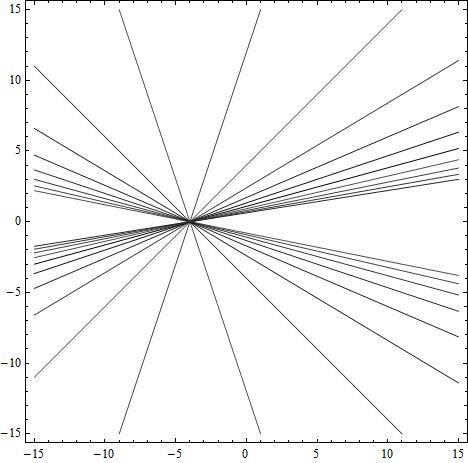 CU-a1is-10-to-0 a2is-2 a3is-4 kis-3.jpg a1 = -10 → 7, a2 = -2, a3 = -4, k = -3 all cubics degenerate in lines when k = -3 for all values of (a1,a2,a3) |
different cubics as variable k varies
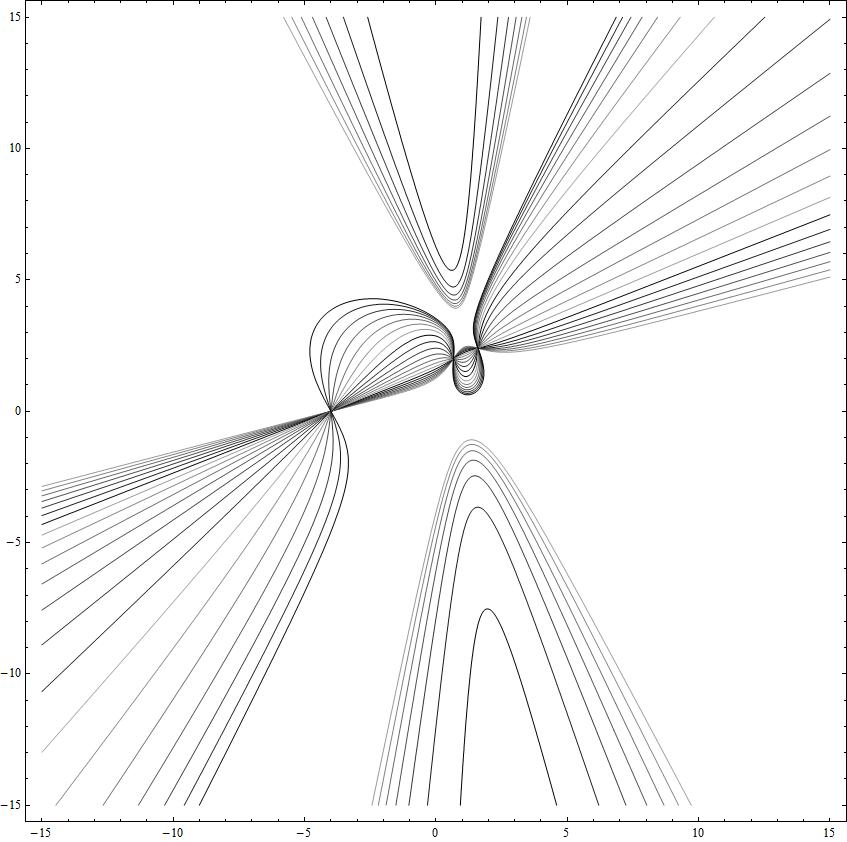
CU-a1is1 a2is-2 a3is-4 kis-10to10.jpg
a1 = 1, a2 = -2, a3 = -10 -> 0, k = -10 -> 10
all cubics pass through the 3 real Flexpoints
when k = -3 the cubic degenerates in a real line and an (imaginary) conic
Picture of CU / HE / CAY
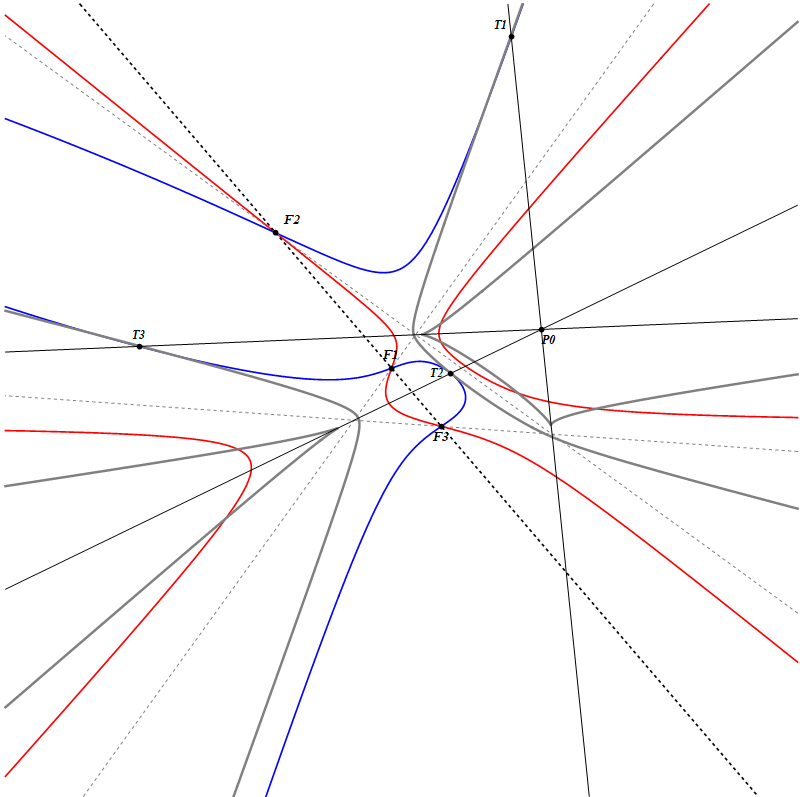
9P-s-Cu1” target=”_blank”>9P-s-Cu1 Hessian-plus Flexlines-41-FE-kRF-example.nb
Reference Cubic CU is red
Hessian HE is blue
Cayleyan CAY is gray
F1, F2, F3 are the real Flexpoints
The 1 gray dotted line is the real Flexline F1F2F3
The 3 light gray dotted lines are the real Flexlines
The 3 black lines are the 3 Fi-Harmonic Polars
T1, T2, T3 are intersection points of corresponding Fi-Tangent and Fi-Harmonic Polar
P0 is the common intersection point of the 3 real Fi-Harmonic Polars
Picture-1 of CU / HE / FE / RF / CAY
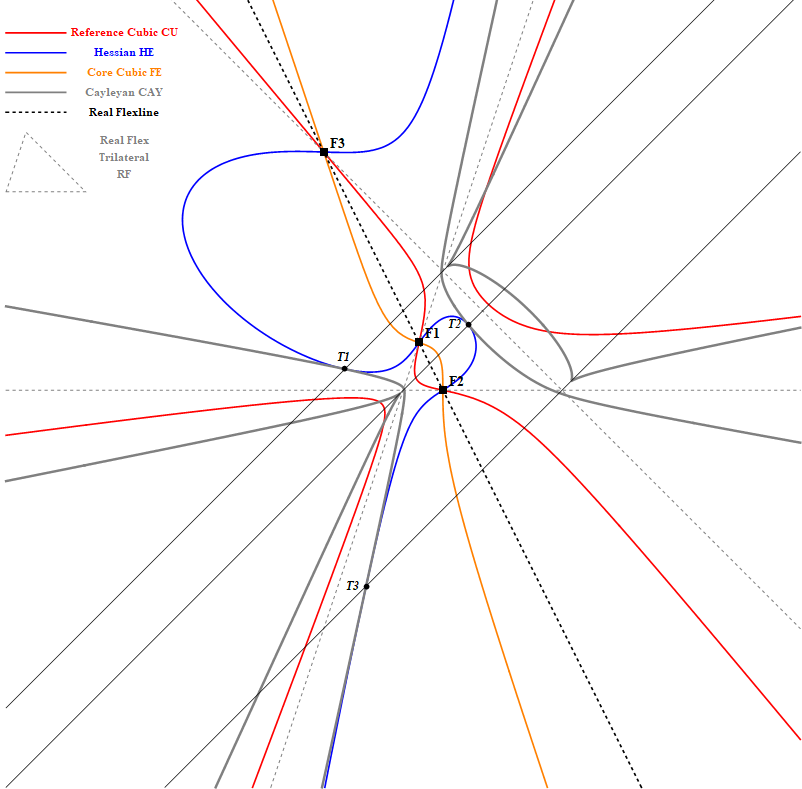
9P-s-Cu1” target=”_blank”>9P-s-Cu1 Hessian-plus Flexlines-54-Normalized-Cayleyan.nb
Picture-2 of CU / HE / FE / RF / CAY
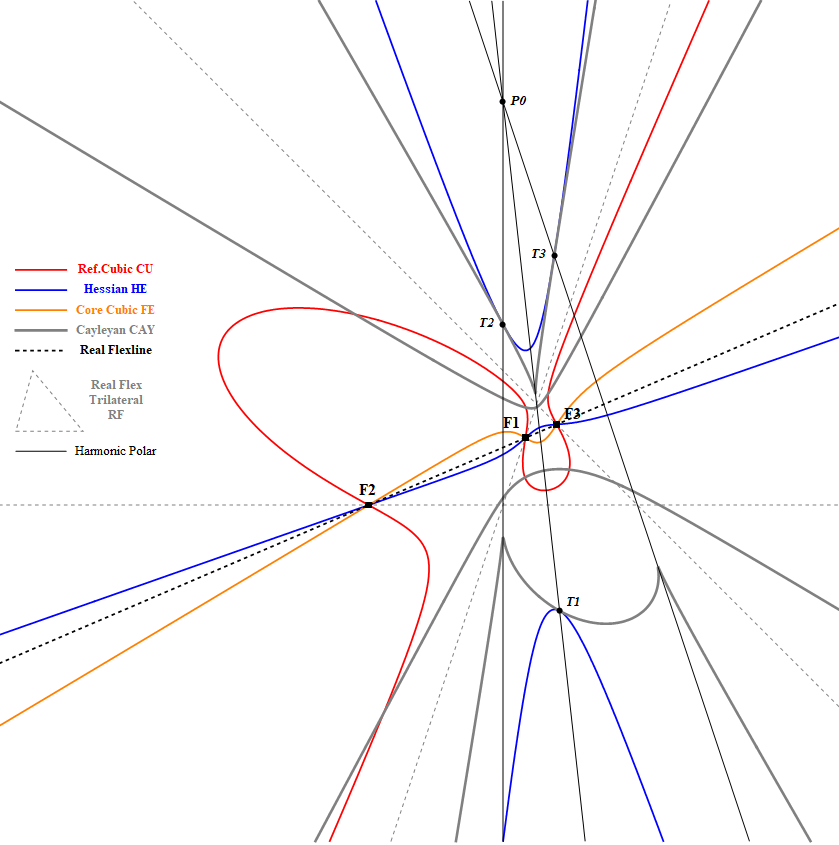
9P-s-Cu1” target=”_blank”>9P-s-Cu1 Hessian-plus Flexlines-55-Normalized-Cayleyan.nb
Picture of CU / HE / pHE1, pHE2, pHe3 (preHessians)

CU-HE-pHE-01.nb
Note 1.
A “primitive cube root of unity” or “primitive third root of 1” is a complex number that, when raised to the power of 3,
equals 1, and it is not equal to 1 itself.
There are exactly three cube roots of unity:
- 1
- i1 = -1/2 + (i √3) / 2
- i2 = i12 = -1/2 – (i √3) / 2
Among these, i1 and i2=i12 are called primitive cube roots of unity because they generate all cube roots of unity when raised to successive powers, and they themselves are not equal to 1.
The primitive cube roots of unity have the following properties:
– i13 = 1
– i1 <> 1 and i2 <>1
– 1 + i1 + i2 = 0
Geometrically, they are the points on the complex plane that form the vertices of an equilateral triangle inscribed in the unit circle, with one vertex at 1.
Estimated human page views: 17
